UNESCO AND THE ISSUE OF CULTURAL DIVERSITY Review ... - ITI
UNESCO AND THE ISSUE OF CULTURAL DIVERSITY Review ... - ITI
UNESCO AND THE ISSUE OF CULTURAL DIVERSITY Review ... - ITI
You also want an ePaper? Increase the reach of your titles
YUMPU automatically turns print PDFs into web optimized ePapers that Google loves.
Foreword<br />
Cultural pluralism is, by definition, an enduring and central feature of the<br />
United Nations Organization. Nevertheless, the way in which cultural differences<br />
have been conceived in theory (ideas) and handled in practice (institutions) has<br />
varied substantially over the Organization’s history. A selective chronological<br />
overview of the platforms and programs of <strong>UNESCO</strong>, the UN agency specifically<br />
charged with cultural issues, cari offer a guide to some of these developments.<br />
While this method of historical sampling may not be all-inclusive, it cari prove<br />
useful in suggesting some theoretical trends and practical implications of<br />
<strong>UNESCO</strong>3 approach to cultural diversity in the past, with a view to reinforcing<br />
and refining efforts in the present and future.<br />
Chronologically speaking, four broad periods emerge in the discourse<br />
and emphasize of <strong>UNESCO</strong> documents (looking primarily at Director-<br />
General3 Reports and, from the mid-1970s, Medium-Term Plans). First,<br />
during the period of post-war reconstruction and the establishment of the UN<br />
and its related agencies, <strong>UNESCO</strong> focused on education and knowledge as<br />
the key to peace, citing for example the Orient-Occident divide as a major<br />
cultural division and source of (needless) misunderstanding and conflict.<br />
This optimistic approach treated nation-states as unitary entities: the<br />
idea of pluralism, diversity, or interculturality (these words, although they<br />
carry different meanings, are often used interchangeably) was therefore<br />
linked to that of international, not intra-national, differences (the terms<br />
‘nation’ and ‘state’ also tend to be used interchangeably to delineate both a<br />
cultural and a political unit, even though in reality these may have blurred or<br />
contradicting geographic boundaries). At this early stage, culture itself seems<br />
to have been thought of more in terms of artistic production and external<br />
practices than as deeply internalized and identity-creating ways of thinking,<br />
feeling, perceiving, and being in the world.<br />
The proliferation of newly independent nations marked the second period,<br />
leading to a shift in definitions and emphasis. The unique cultural identities of<br />
these nations, a justification for their independence and their international<br />
existence, became a central political issue. The concept of culture was expanded<br />
to encompass that of ‘identity’ itself. These developments were accompanied by<br />
two forces: a resistance to the homogenizing effects of uniform technology, and a<br />
largely unspoken fight against the ideological imperialism of powerful states in an<br />
emerging Cold War context. (As it turns out, the Cold War rivalry often gave<br />
smaller states additional leverage and allowed them to ‘manipulate’ the<br />
superpowers to their own advantage.)<br />
3


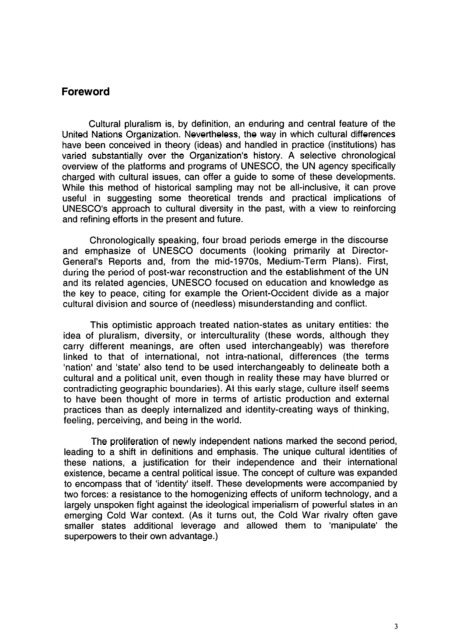

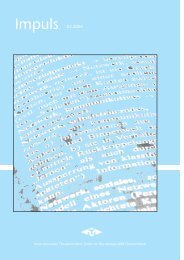
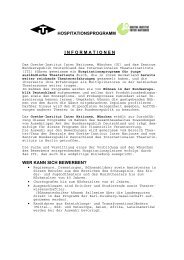
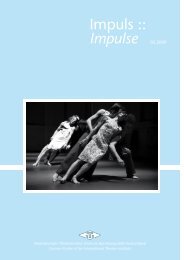
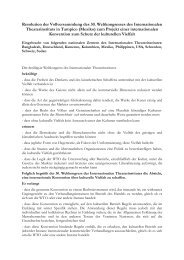
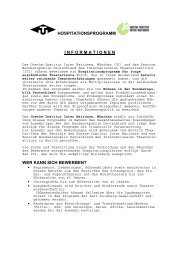
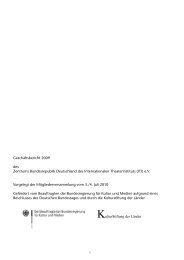
![Geschäftsbericht 2010 [pdf 2 MB] - ITI](https://img.yumpu.com/4380475/1/184x260/geschaftsbericht-2010-pdf-2-mb-iti.jpg?quality=85)